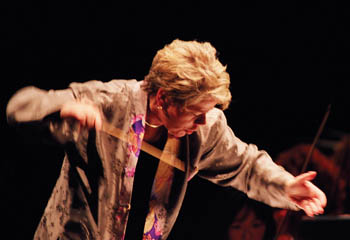![[Metroactive Music]](/music/gifs/music468.gif)
[ Music Index | Santa Cruz Week | SantaCruz Home | Archives ]

Photograph by R.R. Jones Eclectic Conductor: Alsop stabs an unsuspecting musician during one particularly intense rehearsal. Cabrillo Bravo Marin Alsop's quick-study orchestra finishes up another stellar season By Scott MacClelland As expected, conductor Marin Alsop's amazing orchestra dominated the 43rd Cabrillo Festival of Contemporary Music. As expected? In fact, they have spoiled us into taking for granted what no other band in the land could reasonably deliver: brilliant performances of music they have never played--or even heard--before rehearsals began. Some of this repertoire is complex almost beyond comprehension, like Magnus Lindberg's recent Concerto for Orchestra, heard Sunday at Mission San Juan Bautista. Some of it is banal, like Philip Glass' Piano Concerto no. 2 "After Lewis and Clark" and Marijn Simons' A Ti Te Toca, heard the previous weekend in Santa Cruz. In some cases, its conceits nearly cancel out its impact, like Steve Reich's Tehillim and Stewart Wallace's Skvera. But sometimes masterpieces, big and little, come smiling through, including James MacMillan's A Deep but Dazzling Darkness, Kevin Puts' River's Rush, John Mackey's Redline Tango, John Adams' Harmonielehre, Dominick Argento's Reflections on a Hymn Tune and the aforementioned Lindberg. The opening program spotlighted Marijn Simons as both composer and violinist. The precocious Dutch youngster's own violin concerto, Secret Notes, purported a busy orchestral texture that frequently blotted out the solo line and vacillated stylistically between Copland and Pink Floyd, with an accordion thrown into the mix. It sounded callow and distracted next to the MacMillan, a 20-minute concerto inspired by the sufferings of Job, named after a line from a Henry Vaughan poem and recycling as a cantus firmus the famous 15th-century Burgundian song L'homme arme. A Ti Te Toca was the Dutchman's take on Mexican and Cuban music for two pianos and orchestra. While it stirred the ingredients, it left out the spices. Its best moment was a Charles Ivesian hallucination on the Mexican dance song Sandunga. Puts has made an indelible impression at Cabrillo over the last three seasons, not least for his melodic themes and classical forms. River's Rush is a vivid 10-minute cascade of arpeggios that surges climactically. While the Glass concerto gave pianist Paul Barnes a challenge of polymeters, and adds the local color of R. Carlos Nakai's Native American flute, it remains fairly stuck in the Lewis and Clark bicentennial moment and an enervating soak in unrelenting G minor. Reich's Tehillim, psalms sung in Hebrew by the female vocal quartet Tapestry, intones ritualistically in static terms, turning its obscure contrapuntal complexities into a drone of minimalist sameness. Alsop's third orchestral program contained two works that managed to combine tango with klezmer. Mackey's Redline Tango did it by caprice while Wallace's Skvera took up the light fantastic in what otherwise was a sentimental journey to a small village in Ukraine where he hoped to find his Jewish ancestors. But as a concerto, featuring a ferocious reading by guitarist Marc Ribot, the solo and the orchestra passed each other like ships in the night, and not for want of blaring foghorns. Adams' 42-minute Harmonielehre of 1985, in its festival premiere, argued in favor of tonal harmony and large tracts of Reichian minimalism at the beginning and end. Its middle movement, titled "The Amfortas Wound" after that character in Wagner's Parsifal, grew from a doleful trumpet solo into a screaming climax paraphrased from a similar episode in the first movement of Mahler's unfinished 10th Symphony. Though in the final minutes of the work Adams makes the mistake of allowing the combined wind, brass and percussion to drown the desperate strings, the performance overall made a powerful impact. Sunday, at Mission San Juan, Argento skillfully worked tonality, classical form and romantic gesture with an authoritative hand in his Reflections on the 18th-century German (Catholic) hymn tune Ellacombe. The composer opted away from variations in favor of expansive fantasia and even called for the hymn to be vocalized (by orchestra members here) in a quiet moment before the grand Hindemithian finale. Barely over 10 minutes, it was paired off with Kernis' Air, played with thoughtful circumspection by cellist Lee Duckles. The composer (who was present) gave the work a timeless character that might have come from a dozen different composers almost anytime during the last century. [ Santa Cruz Week | Metroactive Central | Archives ]
|
From the August 17-24, 2005 issue of Metro Santa Cruz.
Copyright © 2005 Metro Publishing Inc. Maintained by Boulevards New Media.
For more information about Santa Cruz, visit santacruz.com.